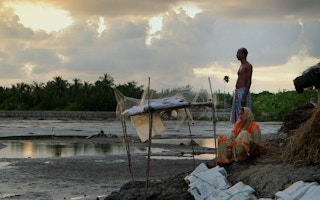The extent to which countries cut their emissions over the next 50 years will determine the conditions of people’s life on earth for at least the next 10,000 years, the head of the Stockholm Resilience Centre at Stockholm University says.
Continued use of oil, natural gas and coal at the current rate will likely raise global temperatures to 2 or 2.5 degrees Celsius above pre-industrial levels, creating conditions that would make life “difficult to manage”, said Johan Rockström.
Even more worryingly, this temperature rise may trigger natural events that would take the planet from 2 degrees Celsius to 6 degrees, which would be “catastrophic”, he said.
“What happens in the coming 50 years will certainly determine the outcome for humanity 10,000 years and beyond,” Rockström said, adding that the last 50 years of human activity has “pushed us away from the stability we’ve been in for the past 12,000 years”.
Rockström is one of a group of scientists proposing that the world halves its carbon dioxide emissions every decade from 2020, by issuing penalties on carbon emitters.
“
These are the kind of domino effects that we are concerned about and where we could end up in a very dangerous situation.
Johan Rockström, head, Stockholm Resilience Centre, Stockholm University
If temperatures approach 2 or 3 degrees Celsius, sea levels are likely to rise at least 7 or 8 metres (23 to 26 feet), and droughts and floods increase to a frequency and severity not seen before. There are also likely to be many more catastrophic weather events such as hurricanes and “massive” heat waves, he said.
Tropical areas of the earth will “very rapidly” move north, and tropical diseases will spread to other latitudes.
This temperature rise may also cause additional trigger events that will warm the planet further, he said.
These include permafrost in Siberia thawing and releasing potent greenhouse gases, forests dying and releasing carbon dioxide, and ice melting which would leave the planet with a darker surface that absorbs the sun’s heat instead of reflecting it.
“These are the kind of domino effects that we are concerned about and where we could end up in a very dangerous situation,” Rockström told the Thomson Reuters Foundation.
If temperatures rise 4 degrees Celsius or more, it will be the first time this has happened in 4 million years - since before modern humans existed, he said.
To have a chance of keeping temperature rise to well below 2 degrees Celsius, as laid out in the Paris climate agreement, countries will need to decarbonise their economies, cut emissions from agriculture and food production, and protect existing natural environments, Rockström said.
They will also need to remove carbon dioxide from the atmosphere using “geoengineering” techniques which are both costly and have not yet been tried out at scale.
But they will be a necessity, he added. “We have gone too far, we have simply emitted too much.”
Business voices
Too often the most vocal groups on climate are environmental non-governmental organisations and climate scientists, Rockström said.
Although their voices are important, over the decades that had led to a mistaken belief that there is a contradiction between economic growth and sustainability, he said.
“It’s very dangerous to have NGOs in the frontline, science a little behind them, because political leaders need to hear the business voice. They are the engine of growth and jobs,” he said.
One reason why the 2015 Paris climate talks were so successful was because “business was there and it was very strong”, he said.
Companies in many sectors see the potential for making money from sustainable growth, he said.
Truck companies can make vehicles that run on electricity, the aviation industry is finding ways to cut emissions, and companies in the construction industry are working on low-carbon alternatives to the current form of cement, for example.
But companies are also hedging their risks. While many are investing in new low-carbon technologies, often under the radar, they also continue to make - and sometimes lobby for - older technologies, Rockström said.
Either way, they will adapt to political realities to make the most profit in the short-term, he said.
“We’re in this Trump administration that doesn’t care about climate change at all, so (businesses in United States) basically adapt to the situation,” he said. “But if we had another administration, they would operate there to make the maximum profit.”
Overall, though, there is a general move towards sustainable economic growth, he said.
China, for example, more than doubled its solar capacity last year, making it the world’s largest producer of solar energy by capacity. It aims to generate 20 percent of its energy without fossil fuels by 2030, up from 11 percent today.
China’s rationale for shifting to clean energy is because it makes good business sense, he said.
“They are adamantly focused on their own growth, their own success and their own prosperity,” he added.
This story was published with permission from Thomson Reuters Foundation, the charitable arm of Thomson Reuters, that covers humanitarian news, climate change, resilience, women’s rights, trafficking and property rights. Visit http://news.trust.org/climate.










